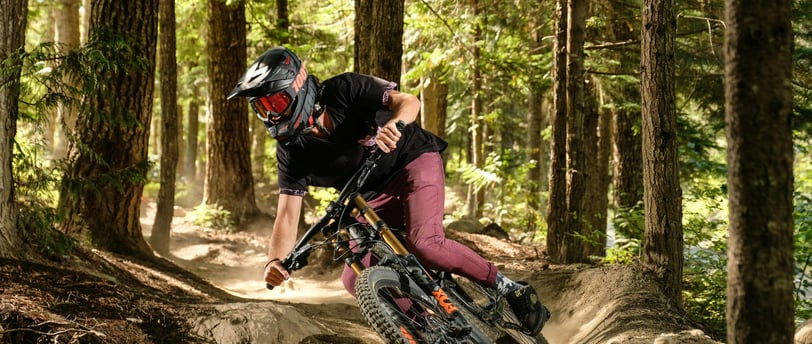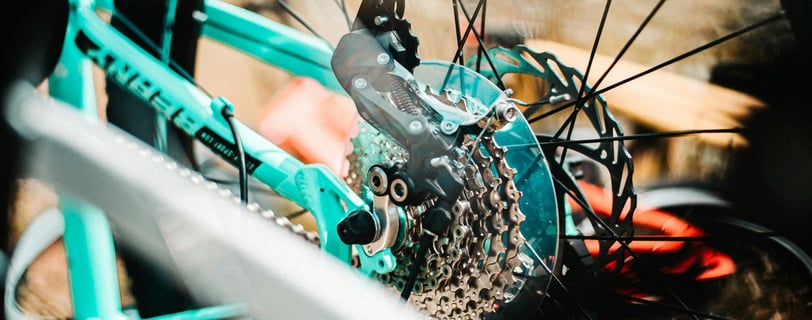Unleash Your Ride: 5 Easy Upgrades to Elevate Your Mountain Biking Experience
Upgrade your mountain biking adventure with these 5 easy tips! From optimizing tires to enhancing brakes and handlebars, elevate your ride for maximum performance and enjoyment on the trails. Explore our comprehensive guide and unleash the full potential of your mountain bike today!
4/9/20247 min read


Mountain biking is not just a recreational activity; it's a passion that fuels adventurers, thrill-seekers, and nature enthusiasts alike. Whether you're conquering rugged trails, navigating steep descents, or cruising through scenic landscapes, the performance of your mountain bike plays a crucial role in shaping your riding experience. However, even the most capable mountain bikes can benefit from upgrades to enhance their capabilities and overall ride quality.
Upgrading your mountain bike isn't merely about keeping up with the latest trends or satisfying the desire for new gear. It's about optimizing your bike's performance, improving comfort, and unlocking its full potential on the trails. From smoother rides to better handling, each upgrade can make a noticeable difference in how your bike performs and how much you enjoy your time on it.
By investing in upgrades, you can tailor your bike to your specific riding style and preferences, whether you're a cross-country racer, downhill daredevil, or trail explorer. Additionally, upgrades can address weaknesses in your bike's stock components, such as insufficient suspension or subpar braking power, ultimately enhancing safety and confidence on challenging terrain.
In this article, we'll explore five easy ways to upgrade your mountain bike, providing practical tips and insights to help you elevate your riding experience. From optimizing your tires and fine-tuning your suspension to upgrading essential components like brakes and handlebars, each upgrade has the potential to transform your bike's performance and your enjoyment of the sport.
Whether you're a seasoned rider looking to take your skills to the next level or a newcomer seeking to personalize your bike, these upgrades offer accessible and effective solutions. So, let's dive in and discover how you can unlock the full potential of your mountain bike with these simple yet impactful upgrades.
1.Tyre Upgrade
A. Importance of Tires in Mountain Biking
Tires are the only point of contact between your mountain bike and the terrain, making them a critical factor in your riding experience. They provide traction, control, and stability, influencing how your bike handles various surfaces and conditions. Whether you're tackling loose gravel, muddy trails, or rocky descents, the right tires can significantly impact your performance and confidence on the trails.
Choosing the Right Tires for Your Terrain
Selecting the appropriate tires for your riding terrain is essential for optimizing performance and enjoyment. Factors to consider include tread pattern, tire width, and compound. For example, aggressive tread patterns with large knobs are ideal for loose or muddy conditions, while less aggressive tread patterns are better suited for hard-packed trails or rocky terrain. Additionally, tire width affects traction, comfort, and rolling resistance, with wider tires offering more grip and stability in rough terrain.
Benefits of Upgrading Tires
Upgrading your mountain bike tires can provide numerous benefits, including improved traction, better cornering grip, enhanced puncture resistance, and reduced rolling resistance. High-quality tires with advanced compounds and tread designs can offer superior performance and durability compared to stock tires, allowing you to push your limits with confidence and control on the trails.
Installation Tips
Installing new mountain bike tires requires attention to detail to ensure proper fit and performance. Start by removing the old tires and inspecting the rims for any damage or debris. Next, carefully mount the new tires, making sure they are seated evenly and securely on the rims. Pay attention to tire directionality and recommended inflation pressures, as these factors can affect performance and durability. Finally, double-check for any signs of tire damage or irregularities before hitting the trails to ensure a safe and enjoyable riding experience.


2. Suspension Tune-Up
Understanding Suspension Components
Mountain bike suspension systems comprise various components, including forks and rear shocks, designed to absorb impacts and maintain traction on rough terrain. Understanding these components and how they interact is crucial for effective suspension tuning.
Signs Your Suspension Needs Attention
Recognizing when your suspension requires adjustment or maintenance is essential for ensuring optimal performance. Common signs include excessive bouncing, bottoming out, or a feeling of harshness over bumps.
Simple Suspension Adjustments
Basic adjustments, such as adjusting air pressure, rebound damping, and compression settings, can significantly improve your bike's suspension performance. Learning how to make these adjustments according to your weight, riding style, and terrain can make a noticeable difference in ride quality.
Upgrading Suspension Components
Upgrading suspension components, such as swapping out stock forks or shocks for higher-performance options, can further enhance your bike's suspension capabilities. Whether it's upgrading to a fork with adjustable damping or installing a rear shock with more sophisticated features, these upgrades can take your bike's suspension to the next level.
3. Dropper Seatpost Installation
Advantages of Dropper Seatposts
Dropper seatposts enable riders to adjust saddle height on the fly, enhancing maneuverability and control on technical descents. They allow riders to lower their saddle out of the way when descending steep terrain, then quickly raise it back up for pedaling efficiency on flat or uphill sections.
Choosing the Right Dropper Seatpost
Selecting the right dropper seatpost involves considerations such as travel length, diameter, and compatibility with your bike frame. Additionally, factors like internal vs. external cable routing and remote lever options can influence your decision.
Step-by-Step Installation Guide
Installing a dropper seatpost involves several steps, including removing the old seatpost, installing the new dropper post, routing cables, and adjusting saddle height and remote lever position. Following a detailed installation guide and consulting manufacturer instructions is crucial for a successful installation.
Tips for Adjusting and Maintaining Dropper Seatposts
Once installed, proper adjustment and maintenance of your dropper seatpost are essential for optimal performance and longevity. This includes regular cleaning, lubrication, and cable tension adjustments to ensure smooth operation on the trails.


4. Brakes Upgrade
Importance of Reliable Brakes
Reliable brakes are crucial for maintaining control and safety on the trails. Whether you're navigating technical descents or maneuvering through tight corners, having brakes you can trust is essential for confident riding. Upgrading your mountain bike brakes can improve stopping power, modulation, and durability, allowing you to ride with greater control and peace of mind.
Signs You Need to Upgrade Your Brakes
Several signs indicate that your brakes may need upgrading, including spongy or inconsistent braking, excessive brake fade, or difficulty modulating braking power. If you find yourself lacking confidence in your bike's braking performance or experiencing frequent brake issues, it may be time to consider upgrading to more reliable brake components.
Options for Brake Upgrades
When it comes to upgrading your mountain bike brakes, you have several options to choose from, including hydraulic disc brakes, mechanical disc brakes, and different brands and models within each category. Hydraulic disc brakes typically offer superior modulation and braking power compared to mechanical disc brakes, but both can provide significant improvements over rim brakes in terms of performance and reliability.
Installation Considerations and Tips
Installing new brake components requires careful attention to detail to ensure proper functionality and safety. Before beginning the installation process, make sure you have the necessary tools and follow manufacturer instructions closely. Pay attention to rotor size compatibility, brake pad alignment, and brake lever positioning to ensure optimal performance and comfort. If you're unsure about any aspect of the installation process, consider seeking assistance from a professional bike mechanic to ensure a successful upgrade.
5. Handlebar and Grips Upgrade
Importance of Comfortable Handlebars and Grips
Handlebars and grips play a crucial role in rider comfort and control, affecting steering precision and damping vibrations from the trail. Comfortable handlebars and grips can reduce hand fatigue and arm pump, allowing you to ride longer and with greater confidence.
Choosing the Right Handlebar and Grips
When upgrading handlebars and grips, consider factors such as material, width, rise, and shape to suit your riding style and preferences. Aluminum and carbon fiber handlebars offer different levels of stiffness and damping properties, while ergonomic grip designs can enhance comfort and control.
Installation Guidelines
Installing new handlebars and grips involves removing old components, adjusting stem height and angle if necessary, and securely attaching the new handlebars and grips to the bike. Follow manufacturer guidelines and torque specifications to ensure proper installation and avoid damage to the components or bike frame.
Benefits of Upgrading Handlebars and Grips
Upgrading handlebars and grips can provide several benefits, including improved comfort, control, and handling. Ergonomic grip designs and vibration-damping materials can reduce hand fatigue and numbness, while wider handlebars and different rise options can enhance steering precision and stability on the trails. Overall, investing in high-quality handlebars and grips can significantly enhance your riding experience and confidence on the bike.
Conclusion
Recap of Upgrades Covered
In this article, we've explored five easy ways to upgrade your mountain bike, from optimizing tires and fine-tuning suspension to upgrading essential components like brakes and handlebars. Each upgrade offers the potential to enhance your bike's performance and your enjoyment of the sport.
Encouragement to Experiment and Customize
Mountain biking is a dynamic and personal pursuit, and experimenting with different upgrades and customizations allows you to tailor your bike to your unique riding style and preferences. Don't be afraid to try new components and adjustments to find what works best for you.
Emphasizing the Impact of Upgrades on Riding Experience
Upgrading your mountain bike isn't just about adding new gear; it's about elevating your riding experience and pushing your limits on the trails. Each upgrade contributes to improved performance, comfort, and control, allowing you to ride with greater confidence and enjoyment.
Final Tips for Successful Upgrading
Before embarking on any upgrades, take the time to research and understand your options, and consult with experienced riders or bike mechanics if needed. Follow proper installation procedures and maintenance practices to ensure optimal performance and safety. Most importantly, have fun exploring new trails and pushing the boundaries of what's possible on your upgraded mountain bike.
